VLC media player is one of the most widely used media player applications on Windows and other operating systems. It is a free and open-source multimedia player developed by VideoLAN. It comes with various standard and advanced features that enhance your experience of watching videos and playing music on your computer. Having said that, VLC is not devoid of problems, just like any other application. It has its share of errors and issues that its users keep experiencing. In this post, we will address some common errors and problems that VLC users have reported. Additionally, we will also list down the fixes that will help you get rid of the said issues.
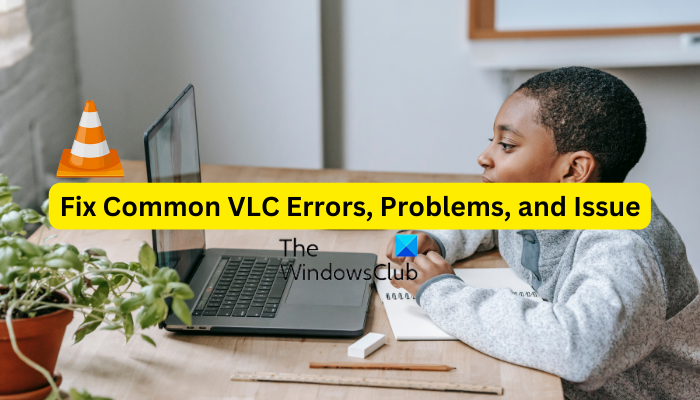
Fix common VLC Errors, Problems, and Issues on Windows PC
Here are the common issues and errors that you might experience while using the VLC media player on your Windows 11/10 computer:
1] VLC media player keeps crashing or freezing
Some VLC users have reported that the app keeps crashing or freezing on their PC. The app suddenly stops and crashes while playing a video or it gets frozen in the middle and becomes unusable. Now, if you are experiencing the same problem, here are the fixes you can use:
- Make sure VLC is up-to-date.
- Turn off hardware acceleration in VLC.
- Run VLC in compatibility mode.
- Reset Preferences.
- Reinstall the VLC media player.
A] Make sure VLC is up-to-date
You might be dealing with VLC crashes and other performance issues because of using an older version of the application. Hence, ensure that you have installed all the available updates for VLC and are using its latest version. To do that, open VLC and go to the Help menu. Now, choose the Check for updates option and it will start checking for available updates. You can download the pending updates by pressing the Yes button. Once done, relaunch VLC to successfully install the updates and check if the problem is resolved or not.
B] Turn off hardware acceleration in VLC
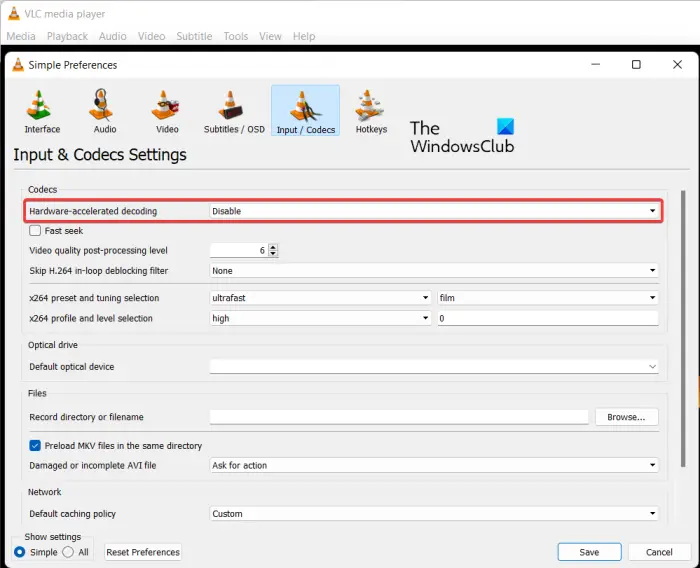
The next thing you can do to fix this issue is to disable hardware acceleration in the VLC app. The use of hardware acceleration on a low-end computer or unsupported system might be making the app unstable and causing it to crash. So, turn it off and then check if the issue is resolved. Here’s how you can do that:
- First, open the VLC media player and go to the Tools menu.
- Now, select the Preferences option.
- Next, move to the Input / Codecs tab.
- After that, click on the drop-down button associated with the Hardware-accelerating decoding option and then choose the Disable option.
- Once done, try playing your videos in VLC and check if it has stopped crashing or freezing.
C] Run VLC in compatibility mode
In case you are running VLC on an older version of Windows, the issue might be caused due to incompatibility. Hence, if the scenario is applicable, run VLC in compatibility mode and check if the issue is resolved or not. To do that, right-click on the VLC desktop shortcut and then choose the Properties option from the appeared context menu. After that, go to the Compatibility tab and check the Run this program in compatibility mode for option, and then choose a previous version to run the app. Once done, press the Apply > OK button and then launch VLC to check if the problem is fixed.
D] Reset Preferences
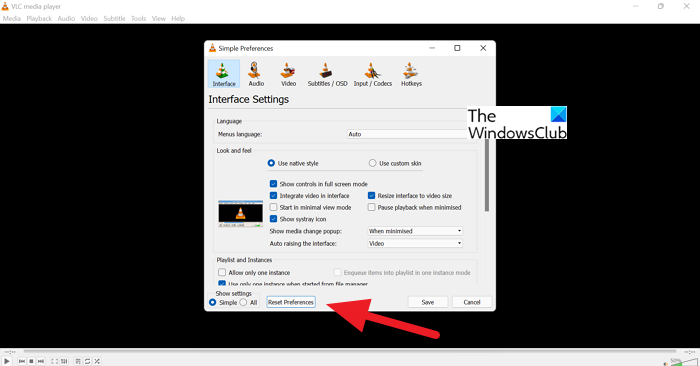
If the problem continues, you can try resetting your preferences and see if it helps. Corrupted app preferences can be one of the reasons behind crashes and other performance issues. So, to fix the problem, reset your settings using the below steps:
- First, launch the VLC media player and click on the Tools menu > Preferences option.
- Now, press the Reset Preferences button and then press OK on the confirmation prompt.
- Next, close the VLC app and open the Run command box using Win+R.
- After that, enter %APPDATA% in Run and then open the vlc folder in the opened location.
- Then, locate the “vlcrc” file and delete it.
- Once done, relaunch VLC and check if the problem is resolved or not.
E] Reinstall the VLC media player
If nothing helps, the last resort is to reinstall the VLC app. You will face crashing, freezing, and other issues if the app installation is corrupted. So, uninstall VLC completely from your computer and then reinstall a fresh and clean copy of it.
Read: VLC media player keeps lagging/stuttering/skipping on Windows.
2] Scrambled video playback in VLC
If you are experiencing the issue of scrambled video playback in your VLC media player, you can use the below fixes to resolve it:
You can disable the hardware acceleration feature in VLC. We have shared the steps to do that earlier in this post.
Another thing you can do is increase the Network Caching value. For that, open VLC and go to the Tools menu > Preferences option. Then, under Show Settings, choose All and go to the Input / Codecs category. After that, look for the Network Caching (ms) option under Advanced, increase its value, and press the Save button.
If you are trying to play a video from an external drive, network drive, or CD/ DVD, try playing it from a local drive. Copy the video and paste it to your desktop. Open the video in VLC and check if the scrambled video playback issue is resolved.
Read: Fix error code 0xc00d36c4 when playing media files on Windows.
3] Your input can’t be opened error in VLC
Several VLC users have reported experiencing the “Your input can’t be opened” error when trying to open a media file. To fix it, you can try changing the path of your file or renaming the file. In case you are trying to enter a video URL, make sure it is working. Furthermore, you can update VLC, reset VLC preferences, temporarily disable your antivirus, or take ownership of the file. If that doesn’t help, reinstall the VLC app to fix the error.
4] VLC not showing video
Another common issue faced by VLC users is that the media player is not playing or showing videos. Also, as per some users, the audio keeps playing while the video doesn’t show up.
If VLC can’t play your videos properly, there can be a number of factors responsible for the issue. It might be caused if you have enabled hardware acceleration in the application settings. Another potential cause can be low file caching or network caching size, Besides that, your default video output mode can also be the problem. A broken VLC settings file and a corrupted installation of the app are some other reasons behind this issue.
If you are facing the same problem, you can use the below solutions:
- Start with standard troubleshooting practices.
- Disable hardware acceleration.
- Modify the File Caching and Network Caching values.
- Select DirectX (DirectDraw) video output mode in VLC.
- Reset VLC preferences.
- Reinstall VLC.
A] Start with standard troubleshooting practices
You can start with generic troubleshooting methods to fix the issue. Just reboot your computer and then check if VLC is showing your videos or not. Apart from that, you also need to check the format of your video and see if it is supported by VLC. Although, there are fewer chances that VLC doesn’t support the format of your video as it supports a wide number of common and uncommon video formats. Here are some other tips you can follow:
- Ensure that your graphics driver is up-to-date.
- Make sure you are using the latest version of VLC.
B] Disable hardware acceleration
Turn off the hardware acceleration feature in VLC to fix the problem of video not showing in the media player. You can refer to the earlier part of the post to know how.
C] Modify the File Caching and Network Caching values
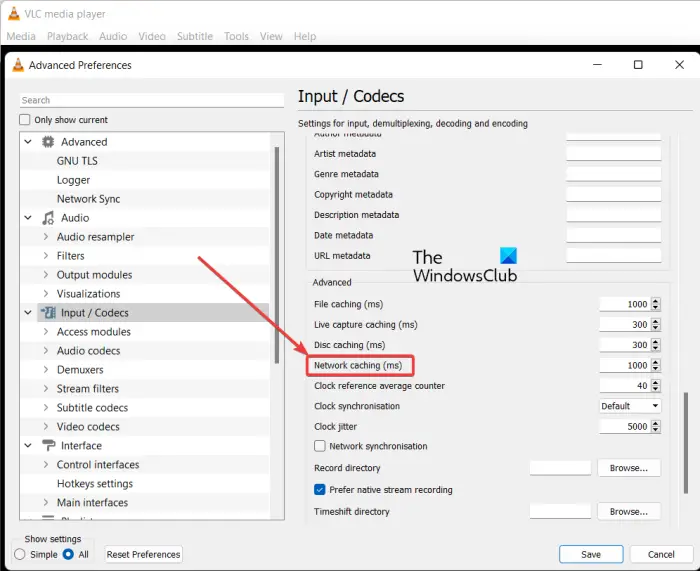
If you are playing an online video in VLC, the problem might be caused due to a low network cache size. Similarly, low file cache size might be causing the issue for locally played videos. Hence, you can try increasing the File Caching and Network Caching values to fix the problem. Here are the steps to do that:
- First, open your VLC app and tap on the Tools menu > Preferences option, or simply press the trl+P hotkey.
- Then, click on the All option present below Show Settings.
- Now, move to the Input / Codecs category.
- Next, locate the File caching (ms) option available under the Advanced section and increase the value. You can set a value of 2000.
- After that, increase the value for the Network caching (ms) option; set a value like 1500.
- Finally, click on the Save button and check if you are able to play your videos or not.
D] Select DirectX (DirectDraw) video output mode in VLC
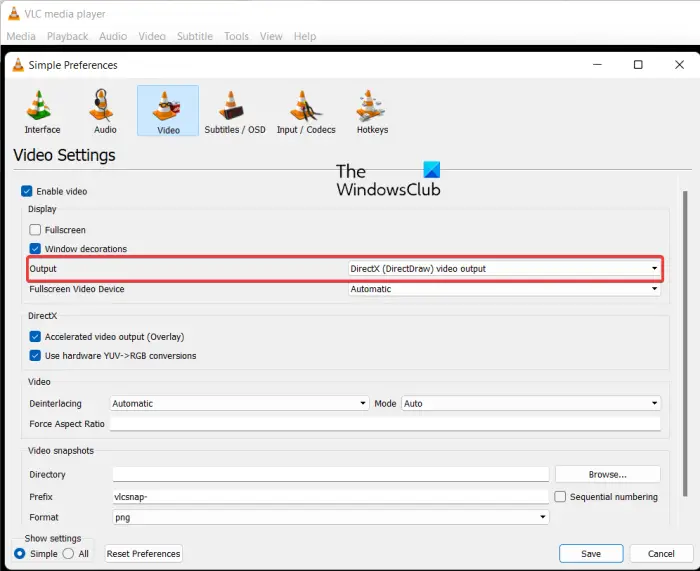
You can try changing the video output mode to DirectX in VLC settings and see if the problem is resolved. Here are the steps to do that:
- First, open VLC and click on Tools > Preferences or press Ctrl+P.
- Now, move to the Video tab.
- After that, press the drop-down button present next to the Output option and select the DirectX (DirectDraw) video output option.
- Finally, press the Save button and then check if you can play your videos without any issues.
In case the problem still persists, use the next fix.
E] Reset VLC preferences
This issue might be caused due to corrupted VLC settings. Hence, if the scenario is applicable, you can reset its preferences to default settings to fix the issue. You can refer to issue (1) to know the exact steps to do that.
F] Reinstall VLC
You can reinstall the VLC app if it is still not able to play videos properly. The problem might lie with the installation of the app. So, remove the current copy and install a clean copy of VLC on your PC.
Read: No sound or audio in VLC on Windows.
5] VLC could not identify the audio or video codec
Some VLC users have reported experiencing the “VLC could not identify the audio or video codec” error while playing MKV or some other videos. To fix it, download and install the missing codecs from online sources, and then try playing your video.
Related: VLC washed out colors & color distortion problem.
Why VLC is not working properly?
There can be several reasons why VLC might not work properly on your PC. If you haven’t downloaded VLC from its official website, the app installer might contain viruses and won’t perform as intended. Besides that, the problem might be caused due to hardware acceleration feature. Corrupted cache settings, using an outdated version, and incorrect VLC installation can be other reasons for this issue.
Now read: How to play RTSP Stream in VLC media player?
Leave a Reply